Tamiya 1/32 P-51D Mustang
|
KIT #: |
60322 |
|
PRICE: |
7840 Yen at
www.hlj.com
(about $100.00)
|
|
DECALS: |
Three options |
|
REVIEWER: |
Tom
Cleaver |
|
NOTES: |
Zotz Decals 32-048 “Duxford Eagles” used. |
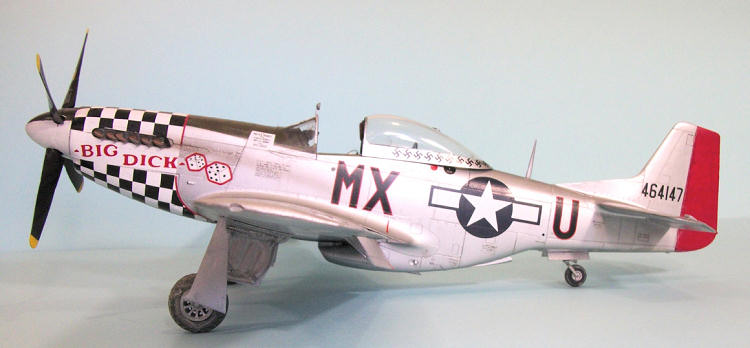
Anyone needing further history of the P-15 Mustang can
find everything you need reading any other review of P-51 kits here at Modeling
Madness:
The
78th Fighter Group and Dick Hewitt:
The 78th
Fighter Group was originally organized at Muroc Army Air Base in the
San Francisco
Bay
Area in early February 1942 after the P-38-equipped 14th
Pursuit Group (Interceptor) was sent to Hamilton Field from March Field in early
January to provide air defense to
San Francisco.
Orders creating the 78th Pursuit Group (Interceptor)
were issued on January 13, and the 14th
Pursuit Group (Interceptor) was split in two at the end of January to form the
new unit.
Following training of the new pilots assigned to the group, the
78th moved to join the 14th
at Hamilton Field in May, 1942, when the unit designations were changed from
“Pursuit Group” to “Fighter Group.”
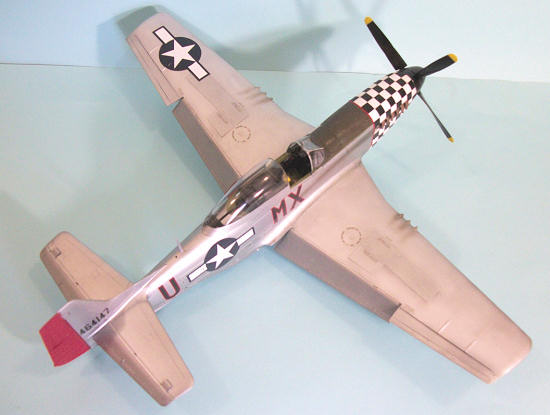 As the Eighth Air Force was being formed in
Britain
in the Spring of 1942, it was originally planned that the 1st,
14th, 78th
and 82nd Fighter Groups would form
the backbone of Eighth Fighter Command.
All four were equipped with the P-38 Lightning, which
was considered the best
U.S.
fighter at the time, with the potential range to operate as an escort fighter
over
Europe.
As the Eighth Air Force was being formed in
Britain
in the Spring of 1942, it was originally planned that the 1st,
14th, 78th
and 82nd Fighter Groups would form
the backbone of Eighth Fighter Command.
All four were equipped with the P-38 Lightning, which
was considered the best
U.S.
fighter at the time, with the potential range to operate as an escort fighter
over
Europe.
The 1st and
14th Fighter Groups - which had
been operational on the P-38 the longest - began moving to England during the
summer of 1942, with the ground echelons traveling aboard the Queen Mary and
Queen Elizabeth, while the aircraft and their pilots made the trans-Atlantic
crossing by air.
The 82nd Fighter
Group followed in September, with the 78th
making the crossing in November.
By the time the 78th
Fighter Group arrived in
England,
the three earlier groups had all been transferred to
North Africa
following the success of Operation Torch, where they would operate in the
Mediterranean Theater for the rest of the war.
In January 1943, losses in the three North African P-38
groups were such that immediate re-supply of scarce aircraft and qualified
pilots meant that the 78th Fighter
Group would be stripped of their aircraft and all pilots other than flight
leaders, with the aircraft and personnel being sent on to North Africa; this was
accomplished by the end of February.
In March 1943, new pilots began arriving, along with the
group’s new mount, the P-47C Thunderbolt.
The 78th,
along with the veteran ex-Eagles of the 4th
Fighter Group and the P-47 experts of the 56th
Fighter Group (the first group to equip on the P-47 a year earlier) would become
the nucleus of Eighth Fighter Command.
From the start, the 78th
was the red-headed stepchild, with the 56th
FG having the most experience with the P-47 and the 4th
FG having the most combat experience due to their previous RAF service.
All three groups began operations in April, 1943.
The ability to escort the bombers was limited by the
P-47's voracious fuel usage for its R-2800 and its small fuel supply.
On internal fuel, the aircraft were hard-pressed to make
it to the Dutch coast, and it was even more difficult for the 78th,
which was based at the former RAF field at Duxford in Cambridgeshire, which was
the westernmost Eight Air Force fighter base and thus the furthest from the area
of operations.
By June 1943, experiments were being made using the
200-gallon fixed ferry tank for the P-47, to extend the fighter’s range.
The problem was that the tank was unpressurized, which
meant that fuel would not draw above 10,000 feet.
Thus, the P-47s could only use these tanks until just
before reaching the far side of the Channel, where they were forced to climb for
altitude and unable to use the tanks further.
Nonetheless, this meant that the P-47s could now fly as
far as the German border.
Still, the bombers were unescorted once they entered
German air space, and the Luftwaffe
made the most of that.
The frustration of American fighter pilots grew as they
could see the massed Luftwaffe fighter
formations in the distance, waiting for the Thunderbolts to turn back before
tearing into the bomber formations.
Things began to change on July 30, 1943, the most
important date in the history of Eighth Fighter Command of the entire war.
The 78th FG
was assigned to penetrate and pick up the bombers as they left Germany.
Aided by a tail wind and the decision to remain at
10,000 feet for as long as possible before switching to internal fuel, the P-47s
were able to penetrate western Germany and pick up the bomber stream
approximately 50 miles east of the Dutch-German border, which was a big surprise
to the still-attacking Luftwaffe, which
normally broke off their attacks just short of the Dutch border to avoid just
such a confrontation with the American escort.
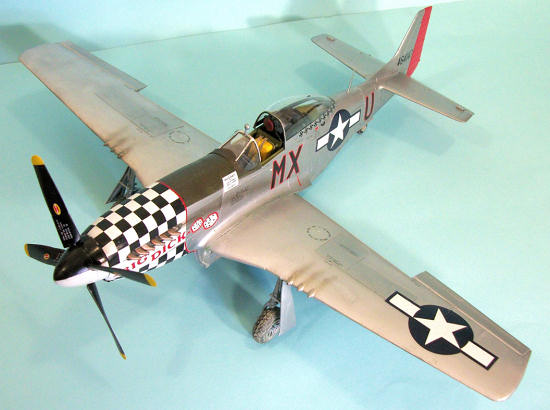 In the swirling combat that ensured, Captain Charles
London of the 83rd Fighter Squadron
shot down two Bf-109s to stretch his score to five and become the first ace of
the Eighth Air Force.
Major Gene Reynolds, Executive Officer of the 82nd
Fighter Squadron scored a triple, while Captain Jack Price of the 82nd
scored a double; both would later become leading aces of the group.
In all, the 78th
made claims for 34 German fighters destroyed.
Coupled with the claims of the 4th
and 56th groups that joined in the
combat, the P-47s of Eighth Fighter Command and scored more victories on this
day than their total previous claims to date, demonstrating that American escort
fighters could meet the Luftwaffe over its home field at long range and defeat
the Germans.
In the swirling combat that ensured, Captain Charles
London of the 83rd Fighter Squadron
shot down two Bf-109s to stretch his score to five and become the first ace of
the Eighth Air Force.
Major Gene Reynolds, Executive Officer of the 82nd
Fighter Squadron scored a triple, while Captain Jack Price of the 82nd
scored a double; both would later become leading aces of the group.
In all, the 78th
made claims for 34 German fighters destroyed.
Coupled with the claims of the 4th
and 56th groups that joined in the
combat, the P-47s of Eighth Fighter Command and scored more victories on this
day than their total previous claims to date, demonstrating that American escort
fighters could meet the Luftwaffe over its home field at long range and defeat
the Germans.
July 30, 1943, was also important for another event.
Homeward bound at low level after the fight, Lieutenant
Quince Brown of the 84th Fighter
Squadron of the 78th FG spotted a
German train and strafed it, leaving it wreathed in steam and stopped.
This was the first ground attack by an Eighth Air Force
fighter, and was a sign of things to come.
In August 1943, brand-new Second Lieutenant Dick Hewitt
arrived at Duxford after training on the P-47, and was assigned to the 82nd
Fighter Squadron.
This was also the month that the P-47s stopped using the
unpressurized ferry tanks and began to utilize the pressurized 75 gallon metal
drop tank, carried on the fuselage centerline.
Still, the fighters could not accompany the bombers all
the way to the target and back.
Within a week of his arrival, Dick had participated in
escorts for the Schweinfurt-Regensburg mission on August 16th,
and an escort to Paris on August 17th.
Following the disaster of “Second Schweinfurt,” also
known as “Black Thursday,” October 14, 1943, when the Luftwaffe effectively
defeated the Eighth Air Force by shooting down 60 of 290 attacking bombers and
damaging so many others that the next day the Eighth couldn’t have sent a combat
box of bombers over Germany, the weather closed in for two months.
This meant the Eighth didn’t have to admit the defeat,
and the time was put into turning things around.
By now the 78th
FG was operating the P-47D, and the Engineering Department of Eighth Fighter
Command had developed pylons that could be fitted under the wing outboard of the
landing gear, allowing the P-47 to carry up to three 75-gallon drop tanks; this
gave the Thunderbolt the range to get almost 2/3 pf the way to Berlin.
At the same time, the 108-gallon paper tank was
developed and put into production by the end of the year.
February 1944 saw the results of all this in the combats
known as Big Week.
The fighters could take the bombers all the way to the
target, with the P-51 Mustangs of the 354th
Fighter Group providing target cover over the most distant targets.
Additionally, the new Mustang-equipped 357th
Fighter Group was transferred from the Ninth to the Eighth Air Force in trade
for the P-47-equipped 358th Fighter
Group, and Don Blakeslee managed to convince the Eighth’s new commander Jimmy
Doolittle to allow the 4th Fighter
Group to crowd into line for re-equipment with the Mustang.
The 78th
was still at a disadvantage in competition with the other fighter groups, since
even with the new long-range tanks their P-47s were still an important 50 miles
further away from the scene of the action than any other group.
By this time, Dick Hewitt had been promoted to 1st
Lieutenant and was an element leader in the 82nd
FS.
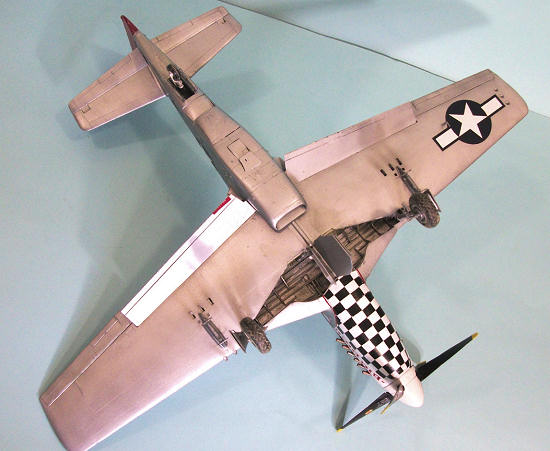 By April 1944, following the Battle of Berlin that began
on March 6, the Luftwaffe was unable to
meet the Eighth in the air.
Orders came for the groups to go after the German
fighters wherever they found them, and the orders came to make strafing attacks
on German airdromes on the return leg of any mission where there was not
significant air combat.
This changed the game completely.
At altitude, in an air combat, there was something
approaching a fair fight, with the quality of the pilot and his airplane being
the deciding factor (after being the first to spot the enemy) in aerial victory.
Attacking an airfield at low level, with up to 100 20mm and 37mm light
anti-aircraft weapons putting up a massive volume of fire to fly through,
changed the odds of survival from skill to chance.
Losses mounted, but P-47 pilots still had a better
chance of getting home even with serious damage than did the P-51 pilots, who
could end up going down as the result of one bullet of any caliber hitting the
cooling system for their Merlin engines.
By April 1944, following the Battle of Berlin that began
on March 6, the Luftwaffe was unable to
meet the Eighth in the air.
Orders came for the groups to go after the German
fighters wherever they found them, and the orders came to make strafing attacks
on German airdromes on the return leg of any mission where there was not
significant air combat.
This changed the game completely.
At altitude, in an air combat, there was something
approaching a fair fight, with the quality of the pilot and his airplane being
the deciding factor (after being the first to spot the enemy) in aerial victory.
Attacking an airfield at low level, with up to 100 20mm and 37mm light
anti-aircraft weapons putting up a massive volume of fire to fly through,
changed the odds of survival from skill to chance.
Losses mounted, but P-47 pilots still had a better
chance of getting home even with serious damage than did the P-51 pilots, who
could end up going down as the result of one bullet of any caliber hitting the
cooling system for their Merlin engines.
At this point in the air war, tactics changed from that
of the more passive close escort of a bomber unit, in which the fighters waited
to ward off an incoming attack and didn’t go haring off after the Germans, the a
more aggressive strategy of hunting the Luftwaffe
fighters to break up their attack before they could get into position and
chasing them as far as necessary. Not all group commanders adopted this more
aggressive strategy, with units like the 78th
FG and 361st FG continuing to
deploy for close escort of the bombers.
It was the adoption of such a tactic by the 4th,
56th, 357th
and 352nd Fighter Groups that led
to the escalation of their group scores during this period.
With the invasion of France that summer, the remaining
P-47 groups in the Eighth Air Force found themselves getting increasing
assignments for fighter-bomber missions in support of the Allied ground forces
in France.
Dick Hewitt, by now a Captain, had finished his combat tour just
before D-Day, and volunteered for a second tour.
He took the mandatory 30-day leave back home to think
his decision over and thus missed the invasion, returning in July to take a
position as a senior flight leader in the 82nd
FS in time to participate in missions supporting the breakout from Saint‑Lô that
ended the Battle of Normandy.
That September, the 78th
provided support for the airborne assault on Arnhem, and did such a good job of
keeping the Luftwaffe off the backs of
the embattled British that they received a Distinguished Unit Citation.
In December, 1944, just before the Battle of the Bulge,
the 78th Fighter Group became the
last Eighth Air Force unit to exchange P-47s for the P-51.
While the pilots were happy to have an airplane that put
them “back in the game” so far as having the range to make longer missions, they
did miss the feeling of safety one had flying the Thunderbolt on strafing and
ground attack missions.
With the Luftwaffe
virtually a spent force, these kinds of missions were more and more the norm,
flown as possible during the worst winter in Europe in a century. Dick Hewitt
allowed his crew chief, an inveterate winner at acey-deucy, to name his new
P-51D-20, which ended up sporting the double-5 dice score known in acey-deucy as
the “Big Dick” (since scoring it usually “screws” the competition) becoming the
name of the new Mustang and an additional play on the name of her pilot.
In March, 1945, Dick Hewitt received a promotion to
Major and assumed command of the 82nd
Fighter Squadron.
He was one of the few fighter pilots in the Eighth to go
from green replacement to unit commander during the course of the war.
At this point, he had 3 strafing credits and 4 aerial
credits.
At the time, there was no official differentiation between such claims
within the fighter groups, a decision made by Eighth Air Force Fighter Command
to encourage pilots to engage in the always highly dangerous strafing attacks.
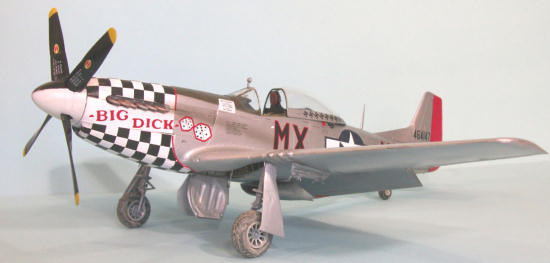 By now, the missions were mostly long-range escorts,
followed by strafing attacks whenever the Luftwaffe
bases could be found with targets.
In mid-April, returning from a mission to
Czechoslovakia, several German airfields around Prague and Pilsen were spotted
with aircraft on them.
A special strafing mission was laid on, and was executed
on April 16, 1945.
Hitting five different airfields, the 78th
made claims of 134 destroyed, the record for strafing destruction by an Eighth
Air Force fighter unit.
Dick Hewitt hit an Me-262 in the landing pattern which
crashed, and a second jet just as it touched down, with the jet swerving off the
runway and exploding. He failed to receive credit for these victories, since his
gun camera failed and his wingman was shot down in the subsequent attack.
This left his wartime score at 4 destroyed on the ground
and 4.5 destroyed in the air.
By now, the missions were mostly long-range escorts,
followed by strafing attacks whenever the Luftwaffe
bases could be found with targets.
In mid-April, returning from a mission to
Czechoslovakia, several German airfields around Prague and Pilsen were spotted
with aircraft on them.
A special strafing mission was laid on, and was executed
on April 16, 1945.
Hitting five different airfields, the 78th
made claims of 134 destroyed, the record for strafing destruction by an Eighth
Air Force fighter unit.
Dick Hewitt hit an Me-262 in the landing pattern which
crashed, and a second jet just as it touched down, with the jet swerving off the
runway and exploding. He failed to receive credit for these victories, since his
gun camera failed and his wingman was shot down in the subsequent attack.
This left his wartime score at 4 destroyed on the ground
and 4.5 destroyed in the air.
The 78th
Fighter Group received a second Distinguished Unit Citation for this mission,
which proved to be their final combat mission of the war.
The 78th
Fighter Group posted an official total of 688 enemy aircraft destroyed in the
air and on the ground with an additional 406 aircraft probably destroyed or
damaged. Fifty pilots accounted for over half of these victories. The
top-scoring fighter squadron in the group was the 82nd
with 102.5 destroyed in the air along with 10 probables and 39.5 damaged, along
with 94.5 destroyed in strafing attacks.
For years, modelers have been hoping that Tamiya would
take the opportunity to “print money” by being the model company to introduce a
1/32 scale “definitive” P-51 Mustang kit.
The old Hasegawa kit from the 1970s has many outline and
detail inaccuracies, while the less said about Trumpeter’s contribution of 1/32
Mustangs with kits that include wings that are irretrievably wrong in not having
a laminar airfoil, the better.
Tamiya came through this summer, with what is definitely
the “definitive” P-51D Mustang. The kit allows a modeler to make either an early
P-51D-5 without the later dorsal fin, or a P-51D-15 or later P-51D-25/30,
through the use of separate tail empennages.
Different canopies are provided, with the early
teardrop, later teardrop and “Dallas” canopy as options.
The different seats and instrument panels are also
catered for.
The only complaint the purists have been able to mount against
the kit 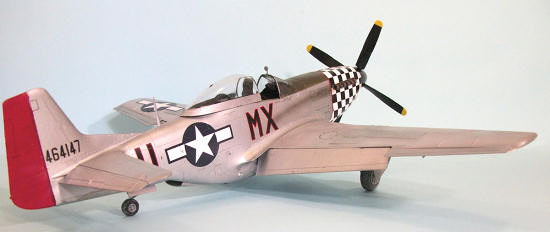 is
that it does not include the early dorsal fin with its slightly-curved outline.
is
that it does not include the early dorsal fin with its slightly-curved outline.
As someone who has been around P-51s for going on 40
years now, I can say that this is the first P-51D kit in any scale that really,
really, really looks like a real P-51D.
The rivet detail is there, very light, very petite,
visible really only close up and in good light, just like a real airplane.
The panel lines are deeper than the real thing, as they
are on any model, but they look good from a couple feet away when the model is
painted, and complaining about that would be to go beyond nit-picking and into
obsessive-compulsive disorder (which is not to say there aren’t those who have
already gone there).
The model comes with separate flaps, ailerons, elevators
and rudder, as well as a complete Packard-Merlin engine under the cowling.
Tamiya has learned from the Spitfire kits, and the
underlying structure for the cowling area, and the attachment of the very thin
cowling panels, is much improved for those who want to go this route.
The gun bays can be posed open with nicely-detailed
weapons, and there is a choice of 75-gallon metal tanks or 108-gallon paper
tanks to hang under the wings, with the different attachments for each.
Decals are provided for an early P-51D of the 20th
Fighter Group, the well-known “Petie 2nd”
of the 352nd Fighter Group, and
“Blondie,” a late P-51D of the 4th
Fighter Group.
Several aftermarket sheets have already been released
for the kit.
When Zotz announced they were going to do a sheet that included
the markings for my good friend Dick Hewitt’s “Big Dick,” my decision was easy
as to what markings to use.
This kit is significantly different from previous Tamiya
kits, and a modeler needs to be aware of the difference if they are to end up
with the model they hoped to create.
The plastic parts of the kit are much thinner and
delicate than any other kit, and they fit very precisely.
If you do not get the fit right on an early part, the
mis-fitting will cascade throughout the project.
The answer to this is to read over the instructions,
take your time in assembly and be sure to test fit parts so you know where and
how they go together before gluing things together.
Of particular importance is bringing the fuselage halves
together, and mating the wing sub-assembly to the fuselage sub-assembly.
The upper wing-to-fuselage joint, if not carefully
fitted, will result in a “ridge” that is not easily dealt with.
If you do take care in assembly, you will only need to
worry about the centerline seam along the bottom of the radiator housing and the
rear fuselage aft of the tailwheel.
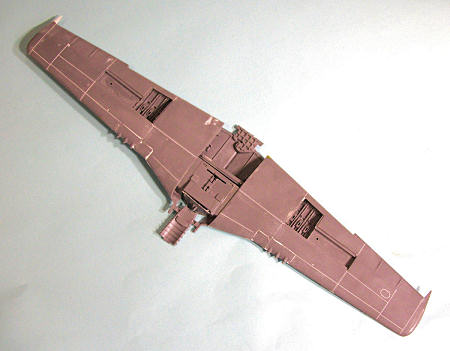 This model was built without the engine, and with the
cowling panels glued shut.
There are other reviews available elsewhere for those
who plan to open up the model.
I suggest that if you do so you plan to super-detail the
engine, with wires, other hoses, etc., since the basic assembly cries out for
this if you are going to display it that way.
This model was built without the engine, and with the
cowling panels glued shut.
There are other reviews available elsewhere for those
who plan to open up the model.
I suggest that if you do so you plan to super-detail the
engine, with wires, other hoses, etc., since the basic assembly cries out for
this if you are going to display it that way.
I began by first pre-painting everything for the cockpit
and the wheel wells according to the painting instructions.
While all that was setting up, I proceeded with some
initial assembly.
First, I sanded down the main wing parts to get rid of
the rivet detail, since I was going to create the “puttied wing.”
The rivet detail goes away easily, leaving just a bit of
a reminder of its presence, which will look right when finished.
I filled the panel lines with Tamiya white surfacer,
then sanded everything smooth, leaving only the gas filler caps for the wing
tanks.
I attached the rear fuselage halves to their respective
forward fuselage halves at this point, so I could glue the joint from inside,
keeping the outer surfaces as clean as possible.
I also assembled the horizontal stabilizers and attached
them, again so I could work the fit from both sides, and get it nice and tight,
with glue applied inside.
I then proceeded with the cockpit assembly.
Tamiya has made different parts to go with the differing
cockpits of the early and late P-51D.
Since Dick Hewitt had told me that his airplane was a
P-51D-25, I went with the parts call-out for “Version A”, the 4th
Fighter Group airplane, in choosing what to put into the cockpit.
I annealed the photoetch seat belts so I could make them
look more natural when draped into the seat.
I then assembled the radiator housing after pre-painting
it.
 With the fuselage interiors done, I attached the
sidewalls in position, then attached the cockpit, being careful to get a good
snug fit (it’s a tight fit so take care there), then attached the radiator
assembly.
I then glued the fuselage halves together and found it was a good
idea to use rubber bands to hold things tight while the Tamiya Extra-Thin Glue
set up (it is slower than glues like Tenax, which I usually use).
With the fuselage interiors done, I attached the
sidewalls in position, then attached the cockpit, being careful to get a good
snug fit (it’s a tight fit so take care there), then attached the radiator
assembly.
I then glued the fuselage halves together and found it was a good
idea to use rubber bands to hold things tight while the Tamiya Extra-Thin Glue
set up (it is slower than glues like Tenax, which I usually use).
I replaced the kit tailwheel leg with the Scale Aircraft
Conversions metal part, assembled the tail wheel and well, and glued that in
position in the rear fuselage.
While that was setting up, I turned to the wing
sub-assembly.
I assembled the wheel well and installed it in position on the
lower wing, and also glued in the second spar.
I then glued the upper wing halves to the lower wing and
set this aside.
I assembled the ailerons, flaps, elevators and rudder, and set
them aside.
I attached the front plate of the cowling, and then the
upper frame.
I attached the thin cowling panels by starting at the bottom and
working up, gluing only the panel edges together from the inside, until the
bottom and side panels were in position.
I then glued these to the interior structure and left
them to set.
I finished off by attaching the upper cowling cover.
If you are very careful in doing this, everything will
come together and look right.
Do not squeeze things into position, or you will end up
mis-aligning the panels.
When the cowling was set up, I then attached the wing
sub-assembly to the fuselage.
I glued the lower wing in position, then made certain to
push the upper wing into position so that there was a smooth join of upper wing
to fuselage, then glued that.
With the basic airframe together, I glued the control
surfaces in position.
I did not use the little metal hinges, since I wasn’t
planning on a toy with “positionable controls.”
 Checking the decals, I realized that the white in the
forwardmost ring of checkerboards is not a decal, so I painted the nose with
Tamiya “flat white” and masked that off.
I also painted the spinner parts white and masked off
the one side.
I painted the rudder white, then finished it with Tamiya “flat
red,” and masked that off.
I painted the anti-glare panel up to a line just aft of
the exhausts with Tamiya “olive drab” and masked that.
I painted the prop and the other side of the spinner
parts with Tamiya “semi-gloss black.”
Checking the decals, I realized that the white in the
forwardmost ring of checkerboards is not a decal, so I painted the nose with
Tamiya “flat white” and masked that off.
I also painted the spinner parts white and masked off
the one side.
I painted the rudder white, then finished it with Tamiya “flat
red,” and masked that off.
I painted the anti-glare panel up to a line just aft of
the exhausts with Tamiya “olive drab” and masked that.
I painted the prop and the other side of the spinner
parts with Tamiya “semi-gloss black.”
The wing was painted with Tamiya “flat aluminum,” with a
coat of Xtracrylix Satin varnish when dry.
The rest of the airframe was painted with Talon
“aluminum.”
I added in a couple drops of blue to do the panels on the aft end
of the radiator housing, then added some Tamiya “gunmetal” to do the cowling
panels immediately aft of the exhausts.
I used the Zotz decals and an old Super Scale stenciling
sheet, all of which went down without problem.
The checkerboard nose decals were very nice because they
are fully opaque and doing them in parts allows everything to fit correctly.
When all the decals were set, I washed off the model to get rid of decal solvent
residue.
I applied exhaust stains and gunfire stains with Tamiya
“smoke.”
The main gear was replaced with the Scale Aircraft Conversions metal
gear and glued in after assembling and attaching the gear doors.
I “muddied” the wheel wells and wheels, since the spring
of 1945 was a rainy time. I then unmasked the windshield and canopy and attached
the canopy in the open position.
The model represents “Big Dick” as the airplane might
have appeared after landing from the Prague strafing mission.
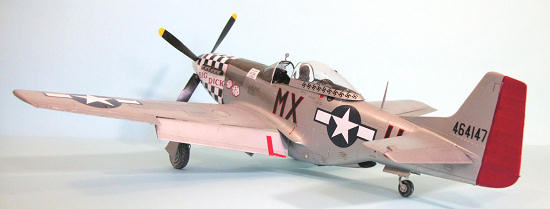 Due to the precision of parts fit and the thinness of
the parts, there will be no Tamiya Mustangs with no-dihedral wings, landing gear
hanging straight down, or canopies sliding up into outer space, the three most
common errors in P-51D models.
Well, never say never, if there is a way to screw up a
model, there are modelers who will find it.
But they’re going to have to go out of their ways to
accomplish that with this kit.
The completed model looks the closest to a real P-51D of
any kit I have ever built.
If the modeler follows instructions and exercises care,
any modeler of average ability should be able to create the best model in their
collection with this kit.
The Tamiya P-51D really is a “game changer,” even moreso
than the Spitfires were, and is definitely Kit Of The Year.
Due to the precision of parts fit and the thinness of
the parts, there will be no Tamiya Mustangs with no-dihedral wings, landing gear
hanging straight down, or canopies sliding up into outer space, the three most
common errors in P-51D models.
Well, never say never, if there is a way to screw up a
model, there are modelers who will find it.
But they’re going to have to go out of their ways to
accomplish that with this kit.
The completed model looks the closest to a real P-51D of
any kit I have ever built.
If the modeler follows instructions and exercises care,
any modeler of average ability should be able to create the best model in their
collection with this kit.
The Tamiya P-51D really is a “game changer,” even moreso
than the Spitfires were, and is definitely Kit Of The Year.
Tom Cleaver
December 2011
Review
kit courtesy HobbyLink Japan.
Order yours at:
http://www.hlj.com/product/TAM60322
Decals courtesy Zotz
Decals.
Order yours at:
http://www.zotzdecals.com/reviews/Zotz32048/zotz32048.htm
Landing gear
courtesy of Scale Aircraft Conversions via Da Boss.
Order yours at:
http://scaleaircraftconversions.com
If you would like your product reviewed fairly and fairly quickly, please contact the editor or see other details in the
Note to
Contributors.
Back to the Main Page
Back to the Review
Index Page



 In the swirling combat that ensured, Captain Charles
London of the 83rd Fighter Squadron
shot down two Bf-109s to stretch his score to five and become the first ace of
the Eighth Air Force.
Major Gene Reynolds, Executive Officer of the 82nd
Fighter Squadron scored a triple, while Captain Jack Price of the 82nd
scored a double; both would later become leading aces of the group.
In all, the 78th
made claims for 34 German fighters destroyed.
Coupled with the claims of the 4th
and 56th groups that joined in the
combat, the P-47s of Eighth Fighter Command and scored more victories on this
day than their total previous claims to date, demonstrating that American escort
fighters could meet the Luftwaffe over its home field at long range and defeat
the Germans.
In the swirling combat that ensured, Captain Charles
London of the 83rd Fighter Squadron
shot down two Bf-109s to stretch his score to five and become the first ace of
the Eighth Air Force.
Major Gene Reynolds, Executive Officer of the 82nd
Fighter Squadron scored a triple, while Captain Jack Price of the 82nd
scored a double; both would later become leading aces of the group.
In all, the 78th
made claims for 34 German fighters destroyed.
Coupled with the claims of the 4th
and 56th groups that joined in the
combat, the P-47s of Eighth Fighter Command and scored more victories on this
day than their total previous claims to date, demonstrating that American escort
fighters could meet the Luftwaffe over its home field at long range and defeat
the Germans.


 is
that it does not include the early dorsal fin with its slightly-curved outline.
is
that it does not include the early dorsal fin with its slightly-curved outline.


